Video of the Week:
Storing and Preserving Peppers
Turfgrass:
Give Cool-Season Grasses a Boost
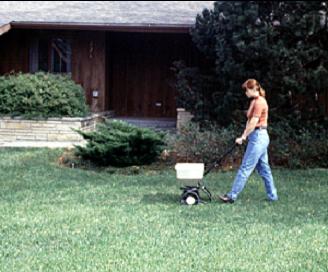
These grasses are entering their fall growth cycle as days shorten and temperatures moderate (especially at night). Cool-season grasses naturally thicken up in the fall by tillering (forming new shoots at the base of existing plants) and, for bluegrass, spreading by underground stems called rhizomes. Consequently, September is the most important time to fertilize these grasses.
Apply 1 to 1.5 pounds of actual nitrogen per 1,000 square feet. The settings recommended on lawn fertilizer bags usually result in about 1 pound of nitrogen per 1,000 square feet. We recommend a quick-release source of nitrogen at this time. Most fertilizers sold in garden centers and department stores contain either quick-release nitrogen or a mixture of quick- and slow-release. Usually only lawn fertilizers recommended for summer use contain slow-release nitrogen. Any of the others should be quick-release.
The second most important fertilization of cool-season grasses also occurs during the fall. A November fertilizer application will help the grass green up earlier next spring and provide the nutrients needed until summer. It also should be quick-release applied at the rate of 1-pound actual nitrogen per 1,000 square feet. (Ward Upham)
Ornamentals:
Trees Losing Bark and Dying
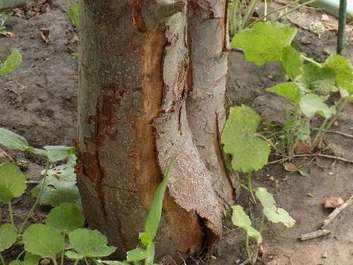
However, this year, we are seeing a wide variety of trees losing more than just the outer layer of bark and then dying quickly. I think what is happening is all related to the November freeze last fall. In this area of Kansas, we went from 69 degrees on November 10 to 19 degrees the following morning. Unfortunately, many trees had not hardened off yet and were damaged. The first sign of damage was marcescence where trees that normally drop their leaves in the fall, didn’t. Leaves didn’t drop because they didn’t have enough time to develop an abscission layer at the base of each leaf that allowed it to fall. Though marcescence itself does not harm the tree, it is a clue that further damage may have occurred.
So, what happened? I think this is all related to damage to the living tissue under the bark. The sharp drop in temperature killed at least a portion the phloem and the cambium. Remember the phloem carries food made in the leaves to all parts of the plants including the roots. The cambium produces new phloem as well as xylem. Xylem will be discussed later. Now that the phloem is dead and the cambium cannot produce new, living phloem, the roots don’t receive the food needed to survive and eventually starve to death.
Why didn’t these trees die immediately? First of all, a healthy root system has stored energy reserves that it can use to keep the tree alive. When those reserves are depleted, the tree dies very quickly.
However, a tree also needs water. Since the living portion of the trunk was killed, wouldn’t this stop water flow? Actually, it would not. The reason it would not is due to how a tree grows and, specifically, how xylem works. Xylem is the structure that carries water from the roots to the top portions of the plant. Even in perfectly healthy trees, most of the xylem is dead. This dead xylem forms hollow tubes that carry the vast majority of water and nutrients throughout the plant. Though there are living xylem cells, the contents of those cells make them inefficient in
moving water. Therefore, the functional portion of the xylem wasn’t hurt by the freeze because it was already dead. Since this xylem system still works, the tree can live for quite a period of time until the roots starve.
Does that mean a tree with cracking or lost bark will die? It all depends on how much of the living tissue under the bark was killed. If only a small portion was killed then the tree may recover. If the entire circumference was killed, it is done for and there isn’t anything you can do to save it. Any portion of the trunk where the bark comes off and the underlying layer is brown is dead.
If you are unsure how much of the trunk was damaged, continue to water the tree as needed until the twigs become brittle. If the twigs become brittle, the tree is dead. (Ward Upham)
Fruit:
Pear Harvest
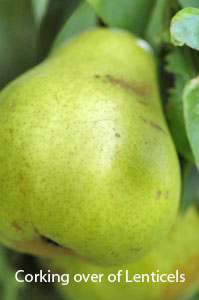
1. A change in the fruit ground color from a dark green to light green or yellowish green. The ground color is the "background" color of the fruit.
2. Fruit should part easily from the branch when it is lifted up and twisted.
3. Corking over of lenticels. Lenticels are the "breathing pores" of the fruit. They start out as a white to greenish white color and turn brown due to corking as the fruit nears maturity. They look like brown “specks” on the fruit.
4. Development of characteristic pear aroma and taste of sampled fruit.
Pears ripen in one to three weeks after harvest if held at 60 to 65 degrees F. They can then be canned or preserved. If you wish to store some for ripening later, fresh-picked fruit should be placed in cold storage at 29 to 31degrees F and 90 percent humidity. Ripen small amounts as needed by moving them to a warmer location and holding them at 60 to 65 degrees F. Storing at too high a temperature (75 degrees F and higher) will result in the fruit breaking down without ripening. (Ward Upham)
Vegetables:
Harvesting Winter Squash
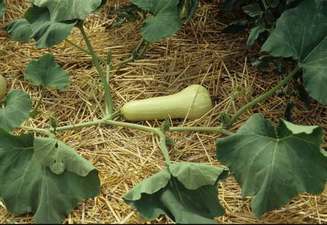
shrivels and rots.
There are two main characteristics that help tell us when winter squash are mature: color and rind toughness.
Winter squash change color as they become mature. Butternut changes from light beige to deep tan. Acorn is a deep green color but has a ground spot that changes from yellow to orange when ripe. Gray or orange is the mature color for hubbard.
A hard, tough rind is another characteristic of mature winter squash. This is easily checked by trying to puncture the rind with your thumbnail or fingernail. If it easily penetrates the skin, the squash is not yet mature and will lose water through the skin -- causing the fruit to dry and shrivel. Also, immature fruit will be of low quality. The stem should also be dry enough that excessive water doesn’t drip from the stem.
Winter squash should be stored cool with elevated humidity. Ideal conditions would be 55 to 60 degrees F and 50 to 70 percent relative humidity. Under such conditions, acorn squash will usually last about 5 to 8 weeks, butternuts 2 to 3 months and hubbards 5 to 6 months. (Ward Upham)
Flowers:
Dividing Daylilies
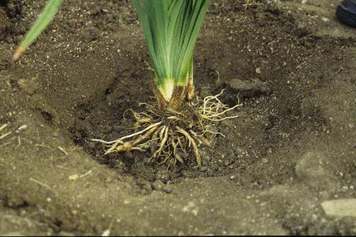
Daylilies have a very tough root system that can make them difficult to divide while in place. Dividing in place is practical if it hasn’t been long since the last division. In such cases, a spading fork can be used to peel fans from the existing clump. If the plants have been in place longer and are well grown together, it is more practical to divide them after the entire clump has been dug.
Use a spade to lift the entire clump out of the ground. Although it is possible to cut the clump apart with a sharp spade, you'll save more roots by using two spading forks back-to-back to divide the clump into sections. Each section should be about the size of a head of cauliflower. An easier method involves using a stream of water from a garden hose to wash the soil from the clump, and then rolling the clump back and forth until the individual divisions separate.
Space divisions 24 to 30 inches apart, and set each at its original depth. The number of flowers will be reduced the first year after division but will return to normal until the plants need to be divided again. (Ward Upham)
Pests:
Uninvited Guests - Crickets
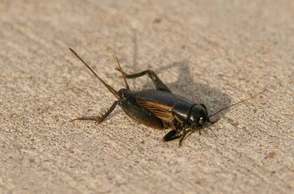
The mere presence of crickets can be annoying. In addition, while the chirping of male insects may be considered beautiful music-in-the-night out-of-doors, indoors it may be regarded as noisy and disruptive. Although not bona fide fabric pests, being what they are (insects with chewing mouthparts) and doing what many insects do (test/taste-their-surroundings), crickets may be responsible for creating holes in and leaving stains on light-colored fabrics (curtains/sheers the oft-cited areas showing damage).
The crickets which enter homes will likely be “field crickets.” Mature field crickets approach an inch in length. The female, is easily identifiable by the presence of her prominent ovipositor measuring another ¾-inch. Most field crickets are all black in color, but some may have a lighter appearance due to their coppery colored wings.
Field crickets overwinter as eggs deposited in the soil. Currently, field crickets are now in their mid-development stages, and for the most part, go unnoticed. By the time cooler fall weather moves in, field crickets will have reached their adult stages. Before and after mating and depositing eggs, crickets move toward sources of heat such as homes and buildings whose exteriors “soak up” the sunlight. Crickets are capable of detecting heat gradients and thus are
drawn in. Once on-the-doorstep, they are a hop away from secretly moving in through any available opening.
How does one go about attempting to prevent cricket “visitors” in homes and possibly business establishments? When cricket populations are large and there is the likelihood of impending invasions, reduction of their numbers may be achieved with insecticide applications as barrier treatments applied to a 6- to12-foot band around the perimeters of homes and businesses.
Once inside, insecticides registered for indoor use against crickets or (in general) indoor invasive species can be applied per labeled instructions. Indoor applications may be general surface, spot, mist or crack and crevice treatments.
Perhaps a more successful approach for preventing cricket “guests” is to exclude them! Again, as previously mentioned, crickets gain entrance via any available crack/crevice/hole/gap. Thus, sealing these portals of entry is a recommended method of exclusion. Attempt to insect-proof houses and buildings by thoroughly inspecting and identifying entry points. Check for cracks and gaps in structure foundations, ill-fitting doorways and garage doors, overhang louvers, chimney vents, roof ducts, soffits, air conditioner connections, outdoor faucets and siding. Use caulk to seal cracks and crevices, weather stripping to make doorways and garage doors tightfitting, and metal screening over/under/behind other entry points. Such simple words. Yet, in all practicality when looking at my home (which I consider sound-and-sealed), I know that there are still remaining untended access points. I expect that like many other people, I will have “fall visitors.” Sort of a fact-of-life that one must accept. (Bob Bauernfeind)
Miscellaneous:
Ornamental Tree Evaluation Guide Update Available
Contributors: Bob Bauernfeind, Entomologist; Ward Upham, Extension Associate
 RSS Feed
RSS Feed
